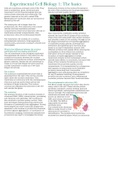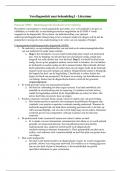Samenvatting
Experimental Cell Biology I full summary
- Vak
- Instelling
This document provides a summary about the basics of cell biology. It is a brief summary about the different cell compartments, such as the cell membrane, nucleus, nucleolus, ER, Golgi apparatus, mitochondria, lysosomes, transport vesicles, cytoskeleton, chloroplasts, the cytosol, ATP, Ion motive f...
[Meer zien]





